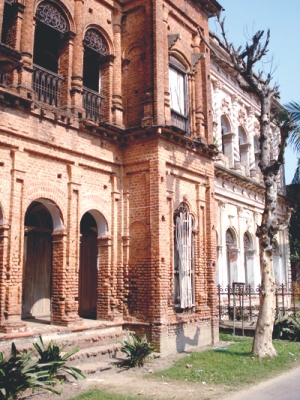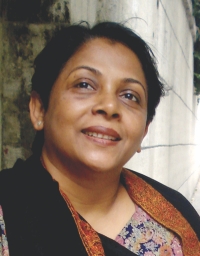| Home - Back Issues - The Team - Contact Us |
 |
| Volume 10 |Issue 39 | October 14, 2011 | |
|
|
Education Where have all the Art Students Gone? FAYZA HAQ
In the world that is growing more and more enamoured of corporate culture, it is hard to find parents who encourage their children to study something as non-corporate as art. Bangladeshi parents in particular, place greater value on careers that will ensure a financially secure future. The apathy of parents towards subjects like fine arts permeates to their children who do not feel motivated to pursue art seriously. Parents often feel that if their child has an BBA or MBA under his or her belt, that makes more sense in the modern rhythm of existence than success in Drawing and Painting. To be a serious art student of “O” or “A” level is just not worth it. Art teachers, like Fareha Zeba, of Scholastica School, who has been teaching for nearly two and a half decades, teaching at her school in Uttara laments that a job at an insurance company is considered more prestigious than being an artist. Siham Sarwath, an A level art student says that often students are discouraged to take up art seriously because their peers think one is a nerd, if one enjoys delving into tomes or any Encyclopaedia of Art or Literature. Art teachers at regular schools say that serious students of “O” and “A” level Arts in Dhaka have dwindled down today to only six and thirty, in O and A levels, respectively this year—in certain schools. Material success appears to be the measurement in the graph of life. An impressive business degree from overseas ensures respect and admiration in any social gathering these days. The ability to do fine etching or sketching does not insure a living. Nothing cuts the ice today as much as mastery over numbers, Finance, Statistics or Economics. Overseas education too means lobbying and financial backing. Zeba says that the attitude of children that what she now deals with is “easy come, easy go” — they treat art like any other subject - to and then throw it up on the answer sheet at the exam hall: “The dedication and motivation is just not there. It's not 'I'll try my best with my colours and brushes as my Art teacher expects from me. My teacher took a lot of care in guiding me. My parents and extended family expect it. That's just not the attitude now. It's often the nouveau riche who tries their hands at Art and fail to be adequately motivated,” say the senior Art teachers. The attitude of the senior students today is often lackadaisical. Being popular with peers and dancing the blues away is the in thing with various English medium school students in Dhaka today. It's difficult to the Facebook and mobile generation to get more serious with their school curriculum says Javed Jalil, a teacher of “The Laurels” in Dhanmandi. These teachers are always spending hours to have a fresh approach to motivating the Art students. Yet it all appears an exercise in futility, says Fareha Zeba.
So why are art students losing interest? The new generation, says Zeba, has little time for these subjects. “Studying History, Literature or Fine Art is something 'weird' according to them. They have little aptitude or background of British History or that of the Subcontinent. 'I”ll do my BBA or MBA and get a corporate job. All my friends feel that studying something like Accounting, Calculus, Statistics or Economics will get me a fine job and status' they say with bravado. The computer and mobile phone generation find “Art' a waste of time and energy." Fareha Zeba says that it is important for teenagers to be in touch with their culture. A large bank balance, or owning some flats, having one's own Porshe, holiday trips to the US or Europe and staying at five star hotels can't be the goal of life. Having a 'cool time' in the Bahamas or the Mediterranean resort or even Goa and Bali is the in thing for young ones today. Mozart, Beethoven, Picasso and Matisse are to be sampled just to be able to be good at repartee at the disco hall or the cards table. Serious studies of Zainul Abedin and Safiuddin is 'all crap for the 'dudes', as they call one another.” Fareha Zeba and other art teachers like Javed Jalil, feel that that pride is knowing our past through Panam City or Sonargaon or Ahsan Manzil or even the Armenian Church.
“Spending money for seeing Picasso's 'Guernica' or a miniature ' Taj Mahal' is not quite popular with our teenagers today – even though they represent culture and civilisation. We tend to forget past glamour and heights of achievements. We have a strong cultural backdrop with the Hindu, Buddhist, Christian and Muslim past. We see this in Paharpur, Mainamati, Rajshahi and even in places in Dhaka like Rayerbazar. We had the Sultan and Mughal periods, and the Hindu and Buddhists, before that. The Portuguese and British have left behind rich monuments and artefacts, in which we can take pride in, such as the Armenian Church, in Old Dhaka. They have all left behind marvellous buildings, monument and carvings. Their architecture, statues, carvings and paintings remain peerless. And yet 'we have no time to stand and stare'. If they are well-to do, students today would rather go playing polo or watch cricket or football performances—which have tickets that cost an arm and a leg. We have our own language and alphabet. But we don't always take pride in speaking our mother tongue,” says Fareha Zeba. “The Dhaka Museum is another spellbinding showcase of Muslim cultural richness. The Lalbagh Fort is another treasure trove of our culture. Every year, I take the students to places of cultural heritage to places such as Mainamati in Comilla. I make the students aware of the richness of terracotta figurines etc. The roads and houses of Sonargaon are visited by students. For sketches and paintings there is nothing better than these monuments – although today they are crumbling. The drawings capture the beauty of the architecture, covered with creepers and branches of trees and hedges. Lalbagh Fort is yet anther scene in Dhaka itself which adds to the knowledge of the students. Mahastangarh in Bogra, the house of Bogra Mohammed Ali are again items to be visited to learn the richness of our cultural heritage, Our own treasure troves should be visited and remembered,” says Zeba. Dedicated teachers of art like Zeba believe that students studying O'level or A'level art should be exposed to our ancient heritage as this will evoke interest in something that they are part of. That perhaps is a prerequisite for anyone who wants to study art.
Copyright
(R) thedailystar.net 2011 |


